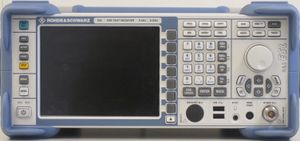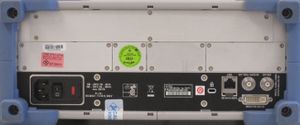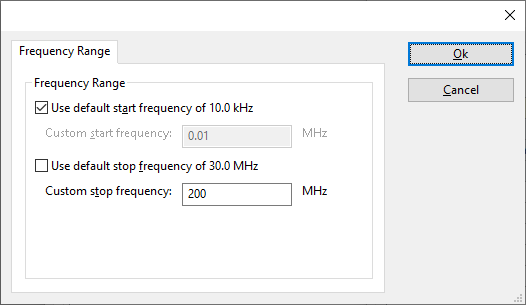Rohde & Schwarz ESL 6
The Rohde & Schwarz ESL 6 device driver is a Spectrum Analyser which is supported by RadiMation®.
Configuration[edit]
The following tabs are available in the advanced configuration of the Rohde & Schwarz ESL 6:
The frequency range of the Rohde & Schwarz ESL 6 as provided by the manufacturer is shown and selected as default. It is possible to overrule these frequencies and to manually adjust the allowed frequency range of the Rohde & Schwarz ESL 6.
| If the checkbox is checked, the default start frequency will be used as the lowest usable frequency in a test for this device. |
| If the Use default start frequency checkbox is unchecked, another start frequency (expressed in MHz) can be specified. The customized start frequency will then be used as the lowest usable frequency in a test for this device. The customized frequency can be a limitation or an extension of the default start frequency. |
| If the checkbox is checked, the default stop frequency will be used as the highest usable frequency in a test for this device. |
| If the Use default stop frequency checkbox is unchecked, another stop frequency (expressed in MHz) can be specified. The customized stop frequency will then be used as the highest usable frequency in a test for this device. The customized frequency can be a limitation or an extension of the default stop frequency. |
Specifying a different frequency range can be useful if for example:
- A device (like a coupler, antenna, injection device, cable, etc...) is still usable (but out of specification) outside the standard suggested frequency range.
- An external mixer is used to measure an extended frequency range.
- An up- or down-convertor is used to shift the frequency range.
- A newer model of a device is present that has an extended frequency range, and still uses the same remote control commands.
Be careful changing these settings as RadiMation® is no longer able to verify if the Rohde & Schwarz ESL 6 is used outside frequency range that is specified by the manufacturer. This may result in serious damage to your measurement device.
Performed Tests[edit]
The following tests has been performed on a R&S ESL6 to verify the functionality of the device driver
General[edit]
- Model: Rohde & Schwarz ESL 6
- Firmware version: 1.83 SP1
- Preamplifier: not tested, option (B22) was not included
- Tracking generator: not tested, option was not included
- Communication over LAN: Ok
- Test date: 2012 february 16th
Receiver mode[edit]
- RBW: Ok (tested: 200 Hz, 9 kHz, 100 kHz, 120 kHz, 300 kHz, 1 Mhz)
- Attenuator: 0, 5, 10, 15, 20, 25, 30, 35, 40, 45, 50 dB
- Initial scan: Peak, Peak + Average, Peak + Average + RMS, Peak + Average + RMS + QP
- Final Measurement Peak Detector: Ok
- Final Measurement QP Detector: Ok
- Final Measurement AVG Detector: Ok
- Final Measurement RMS Detector: Ok
- Linear frequency mode: Ok
- Logarithmic frequency mode: Ok
- Measure time: Ok
Analyser mode[edit]
- RBW: Ok (tested: 200 Hz, 9 kHz, 10 kHz, 120 kHz, 300 kHz, 1 Mhz)
- Reference Level: Ok
- Attenuator: 0, 5, 10, 15, 20, 25, 30, 35, 40, 45, 50 dB
- Sweeptime: Ok
- VBW: Ok
- Initial scan: Peak, Peak + Average, Peak + Average + RMS, Peak + Average + RMS + QP
- Point count: 101 to 32001
- Final Measurement Peak Detector: Ok
- Final Measurement QP Detector: Ok
- Final Measurement AVG Detector: Ok
- Final Measurement RMS Detector: Ok


